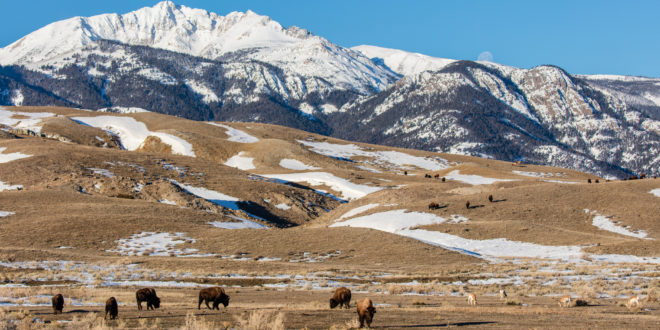Several conservation groups have called on livestock producers to be more proactive in fighting brucellosis in the Greater Yellowstone Area.
The groups argue cattle rangers and livestock organizations have not taken enough steps to mitigate the dangers of brucellosis to their cattle, preferring instead to shift the onus onto wildlife managers.
In particular, the groups condemn current bison management policy as inefficacious and unconscionable.
Every winter, multiple state, federal, and tribal entities manage Yellowstone bison under the Interagency Bison Management Plan, enacted in 2000. The plan calls for reducing the number of Yellowstone bison through hunting and slaughter. This year, 600 to 900 bison could be killed, following last year’s cull of over 1,200 bison.
Although Yellowstone bison numbers are currently stable, biologists have voiced concerns about the fate of Yellowstone’s central bison herd, which, despite being far inside park boundaries and, therefore, far away from the hunting/slaughter zones, has declined dramatically.
Yellowstone bison are managed for a disease called brucellosis, which can cause infected cattle to abort their young and entails costly quarantines or liquidations for producers.
In a joint open letter/policy statement to Governors Steve Bullock (Montana), Matt Mead (Wyoming) and “Butch” Otter (Idaho) published mid-December 2017, the Sierra Club, Wyoming Wildlife Association, and Western Watersheds Project said any effort to manage brucellosis “must be focused on policies, actions, and solutions involving livestock management,” rather than “intrusive manipulation of native wildlife.”
In their letter, the groups cite a report published by the National Academies of Sciences-Engineering-Medicine (NAS) earlier this year highlighting the risk of brucellosis transmission between cattle and elk.
The report bolsters previous research that shows elk are far likelier to infect cattle with the disease than bison. Indeed, there have been no documented cases of bison-to-cattle brucellosis transmission.
You can read the letter in full here.
Glenn Hockett, president of the Gallatin Wildlife Association, recently spoke with the Billings Gazette on the matter, saying “wildlife should be valued and treated like wildlife, not livestock.”
In recent years, IBMP agencies have sought to update the plan to reflect changing attitudes and the best available science available on brucellosis management. To date, however, the partner agencies have been stuck in a stalemate.
This year, Yellowstone National Park has moved ahead with a proposal to start quarantining bison in the Stephens Creek Bison Capture Facility, with the stated goal of curing captured animals of brucellosis.
According to the Gazette, managers with the Montana Fish, Wildlife and Parks and the Montana Department of Livestock have worked to curb interactions between elk and cattle through fencing and hazing. In some cases, the agencies have authorized killing elk to reduce the risk of brucellosis transmission. However, this policy carries its own set of problems. From the Gazette:
“It is difficult, however, to move elk to areas away from cattle and to avoid creating problems for neighboring landowners,” FWP wrote in a report to the Montana Environmental Quality Council, which has the item on its Jan. 17-18 agenda. “It is also expensive to delay cattle grazing in high-risk areas that overlap strongly with elk distributions.”
The Montana Environmental Quality Council, composed of legislators and members of the public, requested information from FWP on eradicating brucellosis in elk at its September meeting. Sen. Mike Phillips, D-Bozeman, asked for the information to steer the discussion away from bison as a disease vector.
“We have spent a lot of time, years and years and years, saying bison are the problem,” Phillips said at the meeting. “We’ve gone out of our way coming up with all kinds of ways to manage the problem. We know without doubt that elk are a vector. So let’s put the bulls-eye at least where it belongs, at the back of the elk, and that’s what that motion does.”
The conclusion by the agency is straightforward: “We believe that with current technology, eradication of brucellosis in free-ranging elk is not possible.”
Other measures proposed for reducing brucellosis risk among elk have included feeding elk birth control drugs and removing elk feedgrounds around Wyoming. The former policy is impractical, while Wyoming has shown no inclination it will pursue the latter.
One policy advocated by organizations like the Gallatin Wildlife Association is a vaccine for cattle that would protect them against brucellosis. Indeed, there is a vaccine currently available against brucellosis for cattle. However, according to the Gazette, it does not prevent brucellosis transmission:
“The currently available cattle vaccine protects against abortion but not infection,” FWP wrote. “Although vaccinated cattle are less likely to transmit the disease, they are not protected from becoming infected.”
Unfortunately for livestock producers, Brucella abortus is listed as a select agent by the federal government. Select agents are “biological agents and toxins that have been determined to have the potential to pose a severe threat to public health and safety, to animal and plant health, or to animal or plant products.”
Because of this listing, only highly secure labs are allowed to study B. abortus to develop a vaccine. De-listing the agent would be a big step toward allowing more research.
FWP officials add that a cattle vaccine would not be a silver bullet for the brucellosis issue, since it would still persist among Yellowstone bison and elk. They also add that, until a vaccine- or management-related breakthrough comes, “existing management tools to reduce or eliminate transmission of brucellosis from elk to cattle are unlikely to significantly change.”
 Yellowstone Insider Your Complete Guide to America's First National Park
Yellowstone Insider Your Complete Guide to America's First National Park





